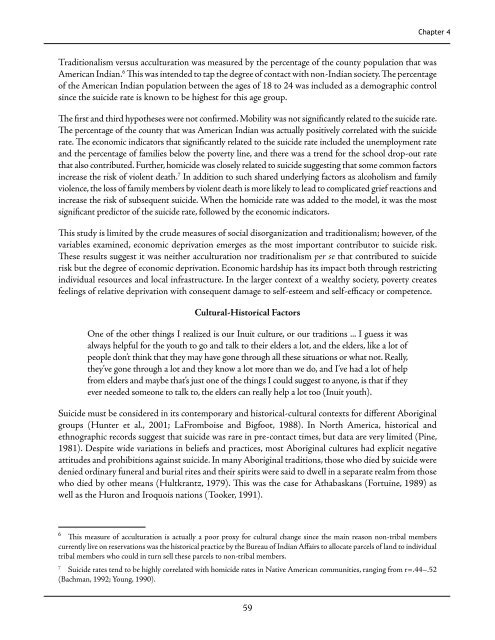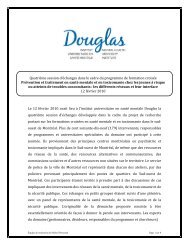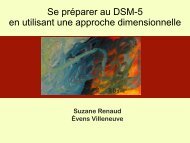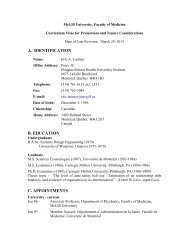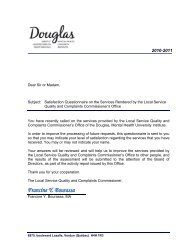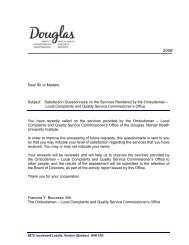Chapter 4Traditionalism versus acculturation was measured by the percentage of the county population that wasAmerican Indian. 6 This was <strong>in</strong>tended to tap the degree of contact with non-Indian society. The percentageof the American Indian population between the ages of 18 to 24 was <strong>in</strong>cluded as a demographic controls<strong>in</strong>ce the suicide rate is known to be highest for this age group.The first and third hypotheses were not confirmed. Mobility was not significantly related to the suicide rate.The percentage of the county that was American Indian was actually positively correlated with the suiciderate. The economic <strong>in</strong>dicators that significantly related to the suicide rate <strong>in</strong>cluded the unemployment rateand the percentage of families below the poverty l<strong>in</strong>e, and there was a trend for the school drop-out ratethat also contributed. Further, homicide was closely related to suicide suggest<strong>in</strong>g that some common factors<strong>in</strong>crease the risk of violent death. 7 In addition to such shared underly<strong>in</strong>g factors as alcoholism and familyviolence, the loss of family members by violent death is more likely to lead to complicated grief reactions and<strong>in</strong>crease the risk of subsequent suicide. When the homicide rate was added to the model, it was the mostsignificant predictor of the suicide rate, followed by the economic <strong>in</strong>dicators.This study is limited by the crude measures of social disorganization and traditionalism; however, of thevariables exam<strong>in</strong>ed, economic deprivation emerges as the most important contributor to suicide risk.These results suggest it was neither acculturation nor traditionalism per se that contributed to suiciderisk but the degree of economic deprivation. Economic hardship has its impact both through restrict<strong>in</strong>g<strong>in</strong>dividual resources and local <strong>in</strong>frastructure. In the larger context of a wealthy society, poverty createsfeel<strong>in</strong>gs of relative deprivation with consequent damage to self-esteem and self-efficacy or competence.Cultural-Historical FactorsOne of the other th<strong>in</strong>gs I realized is our Inuit culture, or our traditions ... I guess it wasalways helpful for the youth to go and talk to their elders a lot, and the elders, like a lot ofpeople don’t th<strong>in</strong>k that they may have gone through all these situations or what not. Really,they’ve gone through a lot and they know a lot more than we do, and I’ve had a lot of helpfrom elders and maybe that’s just one of the th<strong>in</strong>gs I could suggest to anyone, is that if theyever needed someone to talk to, the elders can really help a lot too (Inuit youth).<strong>Suicide</strong> must be considered <strong>in</strong> its contemporary and historical-cultural contexts for different <strong>Aborig<strong>in</strong>al</strong>groups (Hunter et al., 2001; LaFromboise and Bigfoot, 1988). In North America, historical andethnographic records suggest that suicide was rare <strong>in</strong> pre-contact times, but data are very limited (P<strong>in</strong>e,1981). Despite wide variations <strong>in</strong> beliefs and practices, most <strong>Aborig<strong>in</strong>al</strong> cultures had explicit negativeattitudes and prohibitions aga<strong>in</strong>st suicide. In many <strong>Aborig<strong>in</strong>al</strong> traditions, those who died by suicide weredenied ord<strong>in</strong>ary funeral and burial rites and their spirits were said to dwell <strong>in</strong> a separate realm from thosewho died by other means (Hultkrantz, 1979). This was the case for Athabaskans (Fortu<strong>in</strong>e, 1989) aswell as the Huron and Iroquois nations (Tooker, 1991).6This measure of acculturation is actually a poor proxy for cultural change s<strong>in</strong>ce the ma<strong>in</strong> reason non-tribal memberscurrently live on reservations was the historical practice by the Bureau of Indian Affairs to allocate parcels of land to <strong>in</strong>dividualtribal members who could <strong>in</strong> turn sell these parcels to non-tribal members.7<strong>Suicide</strong> rates tend to be highly correlated with homicide rates <strong>in</strong> Native American communities, rang<strong>in</strong>g from r=.44–.52(Bachman, 1992; Young, 1990).59
Chapter 4Altruistic suicide by the <strong>in</strong>curably ill or disabled was described <strong>in</strong> some early historical reports of<strong>Aborig<strong>in</strong>al</strong> people, but it usually seems to have been a response to desperate circumstances. Manyaccounts make no mention of this practice and its true prevalence is unknown (Vogel, 1990). In fact, theepidemics of contagious diseases brought over by European colonizers that decimated the <strong>Aborig<strong>in</strong>al</strong>population may have provoked many suicides through the utter despair felt by <strong>in</strong>dividuals who had losttheir families and communities (Fortu<strong>in</strong>e, 1989; Thornton, 1987; Stannard, 1992).In the boreal or subarctic regions, suicide was sanctioned, <strong>in</strong>deed <strong>in</strong>stitutionalized, as a response to<strong>in</strong>soluble marital problems or as an act of mourn<strong>in</strong>g for the loss of a loved one (Group for the Advancementof Psychiatry, 1989). <strong>Among</strong> the Tl<strong>in</strong>git, suicide was occasionally used as a calculated act of defiance: “An<strong>in</strong>jured person who has no possibility of revenge, or someone who is pursued and sees no way out, takeshis life with the thought that he is thereby <strong>in</strong>jur<strong>in</strong>g his enemy” (Krause, 1956:155). For the Huron <strong>in</strong> theearly 1600s, two common reasons for suicide were excessive grief or vengeance for hav<strong>in</strong>g been wrongedby parents or relatives (Tooker, 1991).Ethnographic accounts of the Inuit suggest that suicide was traditionally sanctioned when an <strong>in</strong>dividualbecame a burden to the group (Leighton and Hughes, 1955). Grief over the death of k<strong>in</strong> was alsorecognized as a legitimate reason for tak<strong>in</strong>g one’s own life. Balikci (1961) described a group of Inuit withmany suicides over a period of several decades, some for seem<strong>in</strong>gly m<strong>in</strong>or frustrations or casual reasons.However, reports of suicide occurr<strong>in</strong>g for <strong>in</strong>significant reasons among <strong>Aborig<strong>in</strong>al</strong> people usually weremade when l<strong>in</strong>guistic and cultural barriers to communication left observers ignorant of the sufferer’spredicament. For example, as noted <strong>in</strong> Chapter 3 of this report, contemporary Inuit youth sometimesreport “boredom” as a reason for attempt<strong>in</strong>g suicide, giv<strong>in</strong>g the superficial appearance that it is a casualact (Kirmayer et al., 1994b). However, “boredom” may mask <strong>in</strong>tense feel<strong>in</strong>gs of empt<strong>in</strong>ess and alienation,and closer exam<strong>in</strong>ation usually reveals significant family conflict and depression ( Jervis et al., 2003).Certa<strong>in</strong>ly, the suicides of contemporary Inuit youth who represent the future of their people do not fitthe traditional Inuit model of altruistic sacrifice by a sick and disabled elder when the family group facesstarvation (Kirmayer, Fletcher, and Boothroyd, 1997).The field of cross-cultural psychology has focused on the broad contrast between egoistic or <strong>in</strong>dividualisticcultures (mak<strong>in</strong>g the <strong>in</strong>dividual always the central value) and those that are sociocentric or communalistic(emphasiz<strong>in</strong>g the value of the family or community). This model must be expanded to encompass thecultural knowledge and values of <strong>Aborig<strong>in</strong>al</strong> people. In some respects, many <strong>Aborig<strong>in</strong>al</strong> communitiesappear sociocentric <strong>in</strong> that the <strong>in</strong>dividual identity is deeply rooted <strong>in</strong> ties to family, band, or community.In other respects, <strong>Aborig<strong>in</strong>al</strong> values conceive the person as more autonomous than the Euro-Americanconcept of the <strong>in</strong>dividual, <strong>in</strong> that traditional values of respect for the <strong>in</strong>dividuals’ own choices and non<strong>in</strong>terferencewith their actions are central to the community (Brant, 1990; Briggs, 1983).In addition to the contrast of <strong>in</strong>dividualistic and sociocentric versions of self, a third aspect, not adequately<strong>in</strong>corporated <strong>in</strong> current psychological models, concerns the role of the environment <strong>in</strong> the experience ofthe ecocentric self. In many traditional <strong>Aborig<strong>in</strong>al</strong> world views, the land, the animals, and the elements areall <strong>in</strong> transaction with self, and <strong>in</strong>deed <strong>in</strong> some sense, constitute aspects of the person (or rather, the humanperson participates <strong>in</strong> these larger more encompass<strong>in</strong>g realities) (Mart<strong>in</strong>, 1978; Stairs, 1992; Tanner,1979). Damage to the land, appropriation of land, and spatial restrictions may all constitute assaults onthe <strong>in</strong>dividual and collective sense of self of those who adhere to this ecocentric world view (Richardson,1991; Wadden, 1991). These environmental attacks on self may have psychological consequences that60
- Page 1 and 2:
Suicide Among Aboriginal Peoplein C
- Page 3 and 4:
Aboriginal Healing Foundation75 Alb
- Page 6 and 7:
Table of ContentsPreface...........
- Page 8 and 9:
Table of ContentsCultural and Lingu
- Page 10:
PrefaceThis report was prepared und
- Page 14 and 15:
GlossaryAmbivalence - Ambivalence r
- Page 16 and 17:
GlossaryParasuicide - Any acute, in
- Page 18 and 19:
Chapter 1IntroductionWhen I was 14
- Page 20 and 21:
Chapter 1Definitions of Suicide and
- Page 22 and 23:
Chapter 1Methods of Studying Suicid
- Page 24 and 25:
Chapter 1suicide attempts (Marttune
- Page 26 and 27: Chapter 1A central problem for cros
- Page 28 and 29: Chapter 2The Epidemiology of Suicid
- Page 30 and 31: Chapter 2the economic status of Abo
- Page 32 and 33: Chapter 2No study to date has syste
- Page 34 and 35: Chapter 2Despite the overall patter
- Page 36 and 37: Chapter 2Figure 2-6) Average Annual
- Page 38 and 39: Chapter 2are only a portion of thos
- Page 40 and 41: Chapter 2Figure 2-9) Suicide Rates
- Page 42 and 43: Chapter 2Indeed, the rising rate of
- Page 44 and 45: Chapter 2Figure 2-11) Number of Dea
- Page 46 and 47: Chapter 2Rate per 100,000 populatio
- Page 48 and 49: Chapter 2There are only a handful o
- Page 50 and 51: Chapter 3Origins of Suicide: Indivi
- Page 52 and 53: Chapter 3Anxiety disorders also car
- Page 54 and 55: Chapter 3Many of the factors associ
- Page 56 and 57: Chapter 3American Indians compared
- Page 58 and 59: Chapter 3genetic and constitutional
- Page 60 and 61: Chapter 3Single-parent families are
- Page 62 and 63: Chapter 3Hopelessness, Problem Solv
- Page 64 and 65: Chapter 3higher rates of suicidal b
- Page 66 and 67: Chapter 3Physical EnvironmentSuicid
- Page 68 and 69: Chapter 31990; Chandler, 1994). Thi
- Page 70 and 71: Chapter 3Risk FactorsDepressionSubs
- Page 72 and 73: Chapter 4Origins of Suicide: Social
- Page 74 and 75: Chapter 4Reserves, Settlements, and
- Page 78 and 79: Chapter 4are equivalent in seriousn
- Page 80 and 81: Chapter 4society (Levy and Kunitz,
- Page 82 and 83: Chapter 4those of mother and homema
- Page 84 and 85: Chapter 4Duncan Campbell Scott, Dep
- Page 86 and 87: Chapter 4Traditional Aboriginal com
- Page 88 and 89: Chapter 4Feehan, 1996; Grant, 1996;
- Page 90 and 91: Chapter 4The Child Welfare System a
- Page 92 and 93: Chapter 4Aboriginal communities and
- Page 94 and 95: Chapter 4had extremely high rates.
- Page 96 and 97: Chapter 4Figure 4-2) Transgeneratio
- Page 98 and 99: Chapter 5What Works in Suicide Prev
- Page 100 and 101: Chapter 5Table 5-1) Strategies of I
- Page 102 and 103: Chapter 5Effective Suicide Preventi
- Page 104 and 105: Chapter 5closet rods that give way
- Page 106 and 107: Chapter 5The American Indian Life S
- Page 108 and 109: Chapter 51) school-based and commun
- Page 110 and 111: Chapter 5reduce suicides that follo
- Page 112 and 113: Chapter 5Although they may visit a
- Page 114 and 115: Chapter 6Conclusion: Understanding
- Page 116 and 117: Chapter 6Figure 6-1) An Integrative
- Page 118 and 119: Chapter 6in large urban settings th
- Page 120 and 121: Chapter 6there’s like a program s
- Page 122 and 123: Chapter 6Figure 6-2) Levels of Inte
- Page 124 and 125: Chapter 6Planning and CoordinationA
- Page 126 and 127:
Chapter 62) The response to the cri
- Page 128:
Chapter 6Often, suicide is a respon
- Page 131 and 132:
Appendix AASIST participants receiv
- Page 133 and 134:
Appendix AThe Training for Youth Ed
- Page 135 and 136:
Appendix AThe program has continued
- Page 137 and 138:
Appendix Awith the creation and imp
- Page 139 and 140:
Appendix AContact Information for R
- Page 142 and 143:
Appendix BAdditional Resources: Man
- Page 144:
Appendix BAboriginal Healing and We
- Page 147 and 148:
Appendix CNational Aboriginal Healt
- Page 149 and 150:
References——— (1987). Unravel
- Page 151 and 152:
ReferencesBeck, A.T., R.A. Steer, M
- Page 153 and 154:
ReferencesBrent, D.A., J.A. Perper,
- Page 155 and 156:
References——— (1995). The Pro
- Page 157 and 158:
ReferencesDevereux, G. (1961). Moha
- Page 159 and 160:
References——— (2005b). In wha
- Page 161 and 162:
ReferencesGardiner, H. and B. Gaida
- Page 163 and 164:
ReferencesGuo, B. and C. Harstall (
- Page 165 and 166:
ReferencesHoberman, H.M. and B.D. G
- Page 167 and 168:
ReferencesJong, M. (2004). Managing
- Page 169 and 170:
ReferencesKouri, R. (2003). Persona
- Page 171 and 172:
References——— (1997). Suicide
- Page 173 and 174:
ReferencesMatheson, L. (1996). The
- Page 175 and 176:
ReferencesNeimeyer, R.A., B. Fortne
- Page 177 and 178:
ReferencesPirkis, J.E., C.E. Irwin,
- Page 179 and 180:
ReferencesRutz, W. (2001). Preventi
- Page 181 and 182:
References——— (1992). Marriag
- Page 183 and 184:
ReferencesTrimble, J. and B. Medici
- Page 185 and 186:
ReferencesWebb, J.P. and W. Willard


